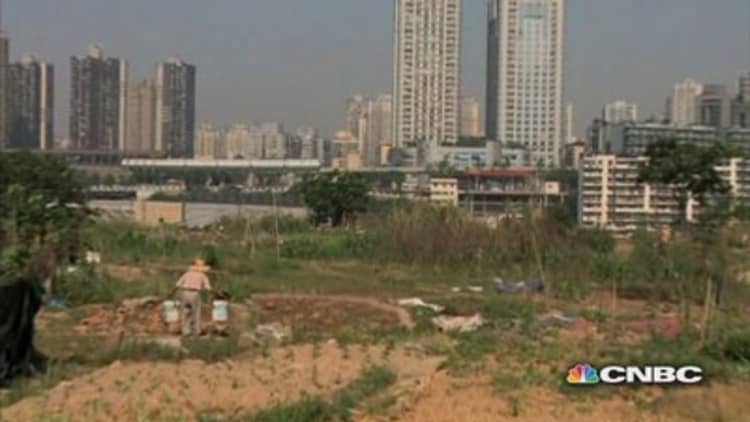In 17 years' time, the world will be tapped out. So better get rich now, or at least face the apocalypse trying. A "perfect storm" of global resource shortages could send you into bunker mode and leave you with some massive Costco receipts and overstocked shelves. But you can't make money from hoarding bottled water—at least not yet. You can, some investment professionals say, make money by investing in the coming apocalypse. It's called resource efficiency investing. Instead of focusing on the world collapsing, these investors focus on the resource efficiency solutions that will avert disaster and be a generator of corporate profits. One such firm is Impax Asset Management, which invests across the globe in resource efficiency themes and companies. We recently spoke with Impax's managing director of equities, Bruce Jenkyn-Jones, about portfolio strategies for the end of the world.
CNBC: How can you invest in scarcity?
Jenkyn-Jones: We turn that proposition on its head. We invest in optimization and resource efficiency as a solution to resource scarcity. There are plenty of opportunities to use resources more efficiently and minimize the impact on the environment, from energy to water, materials, rare earth metals, and food and agriculture. Think of the key resources and the limitations in meeting increasing global demand, and that's where we think opportunities will arise. Our universe of investments falls quite neatly into related areas: including energy efficiency, renewable energy, cleanup, resource recovery and recycling, and the water value chain—from infrastructure to treatment and utilities.
Or take the food and agriculture value chain, and the opportunities born out of population growth coupled with those people wanting to eat more meat rather than vegetables. In food and agriculture we look for efficiency solutions, including reducing spoilage, efficient irrigation and logistics. There is no shortage of food; it's just that there is a lot of waste and the logistics are not in place to produce food where people need it most and that leads to opportunities in logistics, and packaging and preserving.
(Read more: End of the world? You've got 17 years)
CNBC: If we have too much of anything, ironically, the case can be made that it's too much of waste. How do you invest in waste?
Jenkyn-Jones: Waste, recycling and reusing resources we find can be extremely compelling. Resource scarcity arguments lead directly to an economic process that compels more focus on waste management, recycling and reuse. Handling of hazardous materials is not only difficult, but can be difficult to get permits to do, and even when the technology itself is not sophisticated, it's a market where regulations create barriers to entry. Wherever there are requirements to drive a market—such as disposing of waste in a highly regulated way—it's interesting to look for opportunities. We invest in companies involved in clinical waste, hospital waste, and waste coming from industrial facilities, including one of our investments Stericycle and Clean Harbors.
There is also the whole area of "end of life" reuse of materials, including in the vehicle market, and a company we have invested in called LKQ, which reuses and recycles auto parts. We've made a series of successful investments using this approach. There are companies building out franchises through acquisitions of regulated waste sites, getting into markets where they can put up barriers to entry, providing pricing power for a service that producers of waste have to have.
(Read more: Plenty of food, in not enough places)
CNBC: If we aren't running out of stuff—except in the most extreme examples—does this approach really work at a broad thematic level?
Jenkyn-Jones: Scarcity is intrinsically linked with economics, as I said, but take iron, where there is no shortage of the materials, economic opportunities that can be produced by increased use of the material. What we are saying is that use of resources and accelerating use of steel or plastics or oils or vehicle components, is an opportunity that fits into the larger theme, even if these are not absolute scarcity issues. It is usually cheaper to recycle a ton of metal than create a new one.
In a future where there are more people using more metals and plastics, the economic drivers of recycling become compelling—and that can include extracting value from metals in cars, like LKQ. I wouldn't want to claim we're running out of resources by and large, but in a global economy with a growing population and growing wealth, these recycling business models have a clear advantage.
(Read more: Topping off your EV at the store, on school run)
CNBC: What's an example of a real scarce resource that you can invest in?
Jenkyn-Jones: It's water. But, even there, if we want to take the argument to the ultimate extreme, there is no shortage of water, it's just that only 4 percent is fresh, and as demand for it continues to grow, we will be increasingly recycling it and desalinating all over the world. Currently, the economics of desalination work best in the Middle East.
Spending around desalination has been linked to government spending and there have been some impressive projects—including projects from Spain's Abengoa—but the large-scale project business model reliant on government support is cyclical, and as a result we find it generally unattractive.
(Read more: As drought spread, firms could be up the creek)

What you want to do is find a business supplying widgets or filters for the already constructed desalination plant and ongoing operating expense. Many of the global industrial conglomerates are involved here, including GE and Siemens. But it's difficult to invest in a company of that scope or size and target one theme. We found an Israeli company that makes filters for water filtration and treatment plants, Amiad, and Xylem—which was a spinout of ITT, both pure plays for the water resource issue. Pall Corp., which is less of a water desalination pure play, does have a business of providing membranes to filter particles from water. The point is, where you want to be is in the reusable part/replacement parts point of the water value chain. What gets replaced are pumps and filters.
You can also find companies that own and operate existing plants and benefit from rising water prices, but government willingness to support growth of plants is still an issue. And infrastructure will be an investment opportunity. A recycling system to guarantee that Coke and PepsiCo have access to water in emerging markets like India is an example. VA Tech Wabag—spun out of Siemens—builds water infrastructure and water recycling solutions for international companies. Overall, the desalination area has not been as compelling an investment as you might have thought. Long term, though, it's an area for growth we are watching carefully.
CNBC: How do you define resource efficiency investing?
Jenkyn-Jones: With what we are trying to achieve there is no one business that is consistent with this thesis, but the FTSE Environmental Opportunity Index Series [developed by FTSE in conjunction with Impax] is a good place to start. There are approximately 1,500 companies in the world that generate at least 20 percent of their revenue in resource efficiency, defined by FTSE as environmental markets and technologies—those 1,500 feeds into our stock-picking process. [FTSE also offers the Environmental Technology Index, which requires companies to generate at least 50 percent of their revenue from environmental markets and technologies.]
—By Eric Rosenbaum, CNBC.com.






